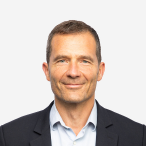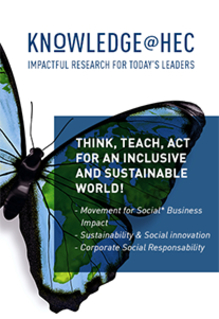Luc Paugam
Associate Professor in Accounting and Mazars “Purposeful Governance” Chair
Luc Paugam, what are your plans for teaching and research in collaboration with Mazars?
Over the next three years, we will focus on pedagogy and research. On the pedagogy front, we've developed and are launching the "Strategy for Impact" certificate this April 2024. This program, with insights from both academics and seasoned consultants from Mazars, empowers students to craft holistic transformation plans aimed at purpose-driven strategies and governance.
Additionally, in partnership with Maximilien Rouer, Mazars' Partner Sustainability leader, we've worked on a business case on Laboratoires Expansience. This case study allows participants to delve into transforming a business into a regenerative organization, showcasing real-world examples of profound changes such as ceasing the production of certain products, reducing greenhouse gas emissions, and restoring biodiversity. We're disseminating this case study via The Case Centre to make it accessible to HEC and other business schools, serving as a catalyst for companies embarking on similar transitions.
On the research front, I'm collaborating with Maximilien Rouer and Marc Biasibetti, Partner Audit & Sustainability Services at Mazars, on experimental research. Currently, in its first pilot phase with over 250 participants, this experiment aims to understand how the increased availability of Environmental, Social, and Governance (ESG) information, expected with the enforcement of the EU’s Corporate Sustainability Reporting Directive (CSRD), may influence firms' sustainability strategies compared to the limited information available today through ESG ratings.
Maximilien Rouer
Engineer and biologist by training, Maximilien Rouer has been an environmental and climate entrepreneur since 2000 when he founded BeCitizen, a leading consulting firm until 2015 (when Greenflex acquired it). In 2005, he pioneered the concept of an economy that restores biodiversity and the climate (now known as a regenerative economy). Having worked at AXA Climate until recently, he joined Mazars in 2023 to establish sustainability consulting services.
Maximilien Rouer, what projects are you collaborating on with Luc Paugam?
First, numerous pioneering leaders warrant analysis to facilitate broader adoption of their approaches. This is precisely our mission alongside Luc. Leveraging trailblazing companies such as Nexans, Pocheco, and Expanscience, we aim to inspire and facilitate the transition toward regenerative practices. With the Mazars chair, creating and disseminating business cases about leading companies helps achieve this objective. Our goal is to equip tomorrow’s leaders with the necessary tools, empowering them to navigate the challenges of an ever-evolving world. For this mission, I conduct experimental research with Luc.
Second, as the CSRD represents a significant shift in the reporting landscape for companies, potentially steering firms away from solely focusing on financial metrics, our collaboration aims to understand the extent to which this reporting shift will influence corporate behaviors, including investment decisions. The research arm of the chair will be dedicated to exploring this facet.
What are the key differences you've noticed between regenerative business, CSR-focused business, and traditional business practices since joining Mazars in 2023, given your 25 years of experience as a sustainable business consultant?
Traditionally, businesses have primarily focused on creating financial value. Their financial statements are meticulously measured, and the goal is to maintain positive results. However, this narrow focus often leads to massive environmental harm.
Corporate social responsibility (CSR) introduced an additional objective for businesses: reducing their impact on the environment and society. A socially responsible company aims to do less harm. Achieving a net-zero impact—where businesses no longer harm the environment or people’s well-being—requires cutting negative impacts. But this approach alone falls short.
Consider the historical negative impacts of business activities on natural capital. Here lies the critical distinction between stocks and flows. The flow perspective accounts only for new impacts, while the stock perspective considers cumulative effects over time.
The concept of a regenerative economy was once known as the positive economy. I introduced this idea in 2005, envisioning an economy with a positive environmental impact1. A positive company maintains its traditional financial profitability objective while actively contributing to five environmental dimensions: energy, climate, biodiversity, resources (including water, soil, and raw materials), and health. Although the terminology has evolved—now emphasizing regenerative business — the fundamental goal remains unchanged: align business models with planetary boundaries. Businesses must not only reduce negative environmental flows but also create positive ones to erase their negative environmental stocks.
Let’s explore two examples: climate change and biodiversity. In the case of climate change, an average company following a business-as-usual approach emits greenhouse gases (GHGs)2. These emissions constitute its net negative GHG flow, contributing to the atmospheric stock of GHGs and exacerbating climate change. In contrast, a company with a regenerative business model would cut its GHG emissions and actively absorb some of the GHGs from the atmosphere.
In terms of biodiversity, the same company destroys natural ecosystems3. Every square meter of land artificialized by its activities represents a negative net flow of biodiversity. This flow diminishes the planet's overall stock of biodiversity, causing Earth’s sixth mass extinction event. In contrast, a regenerative business model goes beyond merely ceasing to harm biodiversity—it actively restores natural ecosystems through its operations.
By exclusively focusing on flows, the CSR dynamic merely mitigates harm without addressing historical stock reduction. Consider climate change: in 2022, annual flows (annual GHG emissions) reached approximately 40 billion tons of CO2 (double the amount in 1970). However, when we examine the stocks, we see that the atmosphere contained 600 billion tons of CO2 before the Industrial Revolution. By 2022, the cumulative CO2 released by human activities through fossil fuel combustion was roughly equivalent (~600 billion tons added). This surge in CO2 concentration elevated atmospheric levels from 280 parts per million4 (ppm) to 421 ppm. Notably, the stable climate that allowed civilizations to flourish was based on a 280-ppm level for 15,000 years. Despite this increase, we have only witnessed a fraction of its effects due to the oceans’ thermal inertia, which tempers the rise in temperature. Without the oceans, our planet would be uninhabitable for humans and most mammals.
The regenerative company must address both flows and stocks.
The regenerative company must address both flows and stocks. In the context of climate change, this means halting the negative flow of GHGs into the atmosphere while actively reabsorbing the 600 billion tons of GHGs emitted since the Industrial Revolution.
From an environmental standpoint, net negative impacts have persisted since the Industrial Revolution. Interestingly, in France, consecutive net negative financial results are illegal for three years in a row.
Given the unpredictable impact of climate change and its disruption of ecosystems, transitioning to a regenerative economy becomes an urgent imperative.
What is missing to align profits and planetary boundaries?
Just to be clear: if legislators and business leaders fully understood the critical state that our planet has already reached in 2024, they would reshape the legislative framework to foster a regenerative economy. For instance, in Europe, alongside the commendable CSRD, which mandates standardized reporting of social and environmental impacts, a “Corporate Regenerative Business Directive” (CRBD) would enforce positive environmental outcomes for companies backed by robust coercive measures. Under this CRBD, non-compliant companies would be barred from trading within the 27-member bloc, supported by mechanisms like the Carbon Border Adjustment Mechanism (CBAM), all aimed at safeguarding the competitiveness of European companies.
On the contrary, the current situation represents a dual failure. On the one hand, there are unconsciously incompetent leaders who fail to grasp the critical vulnerability of our economy5. On the other hand, the legislative framework lacks the capacity to safeguard the common good—the very viability of life on Earth.
Yet, even without an incentive-based legislative framework, enlightened leaders have the power to reverse environmental degradation. The successful implementation of a regenerative strategy hinges entirely on their values and determination.
These visionary leaders do exist. They are diligently preparing their companies for what is to come. Their journey begins with a comprehensive diagnosis of their company’s vulnerabilities and potential. This diagnostic process scrutinizes aspects such as governance, organization, business models, supply chains, products, services, and geographical footprint. Armed with this diagnosis, the manager can take action, akin to a patient recovering after a favorable medical diagnosis.
These visionary leaders do exist. They are diligently preparing their companies for what is to come.
However, these visionary leaders remain a rare breed. Their defining trait lies in their recognition that the Anthropocene6 (or Capitalocene) is not an irreversible fate; transformation is possible, contingent upon a fundamental shift in companies’ business models. These leaders advocate transitioning from resource- and energy-consuming models to ones that actively regenerate these vital resources.
These forward-thinking companies adeptly reorient their business models to achieve a positive net impact. They contribute to energy production, biodiversity enhancement, resource replenishment (including water, soil, and biomass), and even public health (through initiatives like water and soil decontamination). Remarkably, they achieve these outcomes while maintaining financial profitability.
To achieve this level of performance, companies must engage with living organisms—leveraging photosynthesis, the sole process capable of converting sunlight into matter and energy. These companies fall into two categories: those directly linked to living organisms (such as agriculture or forestry) and those indirectly connected (whose activities support photosynthesis and natural cycles, often through their sectoral value chain).
On one hand, the restoration of life is a process that entirely relies on human investments. In the case of a planted forest, it involves choosing the right tree species, distributing seedlings, selecting planting locations, and determining the planting method. The chance of survival of these plants without human intervention is low.
On the other hand, regeneration of life is a process that solely depends on humans for its nesting. Continuing with the example of a forest, humans would ensure that natural regeneration is feasible by introducing a diverse mix of tree seeds. This process promotes synergies among individuals and enhances overall resilience.
The challenge lies in establishing conditions for self-sustaining photosynthesis and natural cycles—creating matter and energy from the sun. Essentially, the company’s strategy should kickstart the restoration of these processes by allocating small-scale financing to enable the living world to reclaim its role in driving regeneration activities. In essence, companies become enablers, fostering an environment where living organisms can thrive, and that will ultimately allow them to reap the rewards of their resilience. A regenerative business strategy champions the strength of living systems, capable of great resilience, provided we cease their destruction.
And how do you make sure that these new ways of leading business activities don’t have long-term externalities, such as in business as usual?
In a world detached from the living ecosystem, companies following a business-as-usual approach operate within silos and adhere to linear thinking. Unfortunately, this approach lacks systemic vision. Solving a problem in one silo often spawns new challenges in adjacent ones, leading to the adage that ‘today’s solutions become tomorrow’s problems.’ To break free from this cycle, we must draw inspiration from the fundamental principles of life, honed over hundreds of millions of years. I explored these principles during my tenure at AXA Climate when we co-built the Butterfly training program.
Refocusing on living organisms allows us to recreate conditions akin to homeostasis. Here are some of these guiding principles:
- Perpetual Sub-Optimality: Living organisms operate below peak efficiency. Take photosynthesis, for instance, where the conversion efficiency from received energy to transformed energy remains less than 1%. Paradoxically, this sub-optimality ensures the stability of carbon cycles. If efficiency were higher, rapid and violent carbon fluctuations would ensue, leading to alternating periods of overproduction and total collapse of life.
- Cultivating Diversity: Living systems thrive on diversity. To withstand variations in sunlight and rainfall, the capacity to transform resources must be distributed across different organisms. Biodiversity fosters resilience.
- Zero Waste: Unlike our linear models, living organisms don’t generate waste. Outputs serve as input elsewhere, creating a circular flow of materials.
- Decentralization: Living systems do not have a central command. Instead, they operate through decentralized interactions, allowing adaptation and resilience to emerge organically.
- Interdependent Growth: Growth in living organisms is interwoven. It’s not about relentless expansion but harmonious development within ecological limits.
By embracing these principles, we can shift from a destructive trajectory to one that nurtures life and sustains our planet. A company’s business model structured around indicators derived from fundamental life principles can prevent these innovative business approaches from becoming tomorrow’s challenges.
One significant obstacle lies in financing the transition from our degraded and dysfunctional ecosystems to functional ones.
However, one significant obstacle lies in financing the transition from our degraded and dysfunctional ecosystems to functional ones. Restoring ecosystem services induces costs (resembling a J curve), and this process takes time. During this transition, old models cease to function effectively while new models are still in their infancy.
Consider agriculture an example: The prevailing model relies on genetically weakened plants grown in inert soil, supported by synthetic fertilizers and pesticides. Unfortunately, conventional agriculture yields negative energy, climate impact, resource use, and public health outcomes. Yet, agriculture inherently possesses the potential for positive results. Soils are degraded, seeds struggle to survive without human intervention, and climate change exacerbates the situation. Additionally, farmers need to acquire new skills. Transitioning from this system to a regenerative agricultural approach will require time. For instance, in France, it takes an average of eight years to regenerate soil using conservation farming methods. But who will finance these years of necessary low agricultural yields until the soil rejuvenates and can sustain crops? The challenge lies in external risks and primarily in financing this transformative journey.
Here’s an idea: In 2008, European financial institutions swiftly released 1,000 billion euros through Long-Term Refinancing Operations (LTROs)7 to address the financial crisis. Why not employ a similar approach to fund the J curve of transitioning from one economic model to another?
What are the difficulties in getting businesses to apply your strategies?
As I mentioned above, there are no regulations or laws pushing companies to become regenerative in the medium term and no GDP-like indicators that would measure resource regeneration. This keeps companies stuck in a rut of volumetric growth.
Consequently, when faced with a choice between revenue growth—recognized and valued by all—and the company's resilience, the decision almost invariably leans toward growth. Christopher Guérin, CEO of Nexans, articulates this better than I can, having courageously pulled out from this rut. (Read Christopher Guérin's interview on Knowledge@HEC here).
Choosing a regenerative strategy to safeguard a company against emerging physical or transitional risks remains remarkably visionary, especially within a context that often prioritizes resource exploitation.
Choosing a regenerative strategy to safeguard a company against emerging physical or transitional risks remains remarkably visionary, especially within a context that often prioritizes resource exploitation—without bearing the full consequences of such actions. This situation echoes the well-known adage: 'privatizing profits and socializing losses.'
Why do so few businesses fail to heed the scientific warning and obvious climate change and move towards a new business and life paradigm?
Businesses today grapple with a fundamental dilemma: their core purpose still revolves around profit generation, yet they also bear a fiduciary responsibility to address the risks posed by climate change. Consequently, they strive to fulfill their profit objectives while minimizing costs associated with physical or transitional risks. However, cost-cutting alone does not necessarily drive a shift in their business model; in fact, it often leads to the opposite outcome.
For true transformation, executives must recognize the gravity of risks posed by planetary boundaries—not only on society at large but specifically on their own companies. Failing to do so risks a case of the blind leading the blind.
This awareness must permeate executive ranks and boardrooms. Only then can a company fully appreciate scientific warnings and actively pursue business model transformation. Unfortunately, a historical lack of expertise among executives and boards persists. While schools are gradually incorporating climate change education, economic theories still predominantly rely on the assumption of unlimited planetary resources.
Furthermore, ongoing education carries a high access cost. Personally, I estimate that executives need between 30 and 300 hours to comprehend the urgency of our situation, depending on their scientific background. Though non-productive by traditional standards, these hours are essential for grasping the extent of the risk, as underscored by scientists.
But how can busy executives find time for this crucial learning? The challenge is formidable, especially considering the cognitive bias introduced by the Dunning-Kruger effect, which fosters overconfidence among those with limited knowledge.
Moreover, in an environment where unsettling news often faces rejection (akin to the fate of Cassandra), the path forward remains complex. Nobody wants to listen to Cassandra; everyone prefers to ignore the uncomfortable truths they bring. This phenomenon has been described as a “schism of reality” by German philosopher Oskar Negt, inspired for example by the denial of the rise of Nazism by the Weimar Republic until it was too late, or as “doublethink” by George Orwell in his book "1984," where people learn to accept two conflicting beliefs as truth simultaneously. This intellectual stance allows pretending until reality catches up with the individual. And it always does.
Psychologically, not knowing serves as a protective mechanism. According to the British psychoanalyst Sally Weintrobe, unconscious defense mechanisms, created to defend against anxiety, distort external reality, thus protecting our internal representation of our world. Distortions exist as (poor) solutions to a reality that “has become too obvious to be ignored…”
Lastly, the normative pressure exerted by a consumption-centered society causes us to ignore the consequences of mass consumption and hinders meaningful change.
1Maximilien Rouer, « Du bâtiment positif à l’Économie Positive », La Tribune, Dec 2005, and Maximilien Rouer, Anne Gouyon, Réparer la planète – La révolution de l’Économie Positive, JC Lattès éd., 2007.
2Through energy consumption linked to the extraction or production of raw materials, industrial transformation, transport, storage, etc.
3Through constructing buildings or infrastructures that replace natural ecosystems, distributing toxic molecules that poison living organisms, etc.
4Number of CO2 molecules per million air molecules.
5Burning fossil fuels results in the rapid release of CO2 into the atmosphere — a carbon dioxide that had been sequestered by plants over hundreds of millions of years. Few realize that throughout Earth’s 4.5-billion-year history, the average global temperature reached levels inhospitable to mammalian life. For instance, sediment records indicate that 2.7 billion years ago, the climate was stifling, with oceans at temperatures of 80 °C (176 °F), fuelled by an atmosphere rich in CO2 and methane.
6The Anthropocene is a new geological epoch characterised by the ascendancy of human beings as the primary force of change on Earth, surpassing geophysical forces.
7Long-Term Refinancing Operations (LTROs) involve the European Central Bank granting long-term loans (typically three years) to commercial banks. These operations, considered unconventional monetary policies due to their significant scale, serve to infuse liquidity into the financial system.
Research on CSRD: How Will New European ESG Reporting Standards Affect Companies? by HEC professor Marieke Huysentruyt.
(In French): « Non, les normes ne sont pas neutres » : la tribune de Luc Paugam, Maximilien Rouer et Hervé Stolowy.










